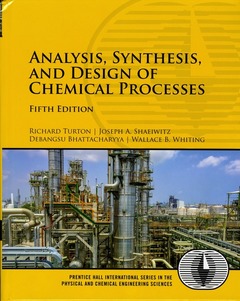Description
Analysis, Synthesis, and Design of Chemical Processes (5th Ed.)
International Series in the Physical and Chemical Engineering Sciences Series
Authors: Turton Richard, Shaeiwitz Joseph, Bhattacharyya Debangsu, Whiting Wallace
Language: English
Subject for Analysis, Synthesis, and Design of Chemical Processes:
179.12 €
In Print (Delivery period: 14 days).
Add to cart1520 p. · 20.8x25.8 cm · Hardback
Description
/li>Contents
/li>Biography
/li>Comment
/li>
The Leading Integrated Chemical Process Design Guide: With Extensive Coverage of Equipment Design and Other Key Topics
More than ever, effective design is the focal point of sound chemical engineering. Analysis, Synthesis, and Design of Chemical Processes, Fifth Edition, presents design as a creative process that integrates the big-picture and small details, and knows which to stress when and why. Realistic from start to finish, it moves readers beyond classroom exercises into open-ended, real-world problem solving. The authors introduce up-to-date, integrated techniques ranging from finance to operations, and new plant design to existing process optimization.
The fifth edition includes updated safety and ethics resources and economic factors indices, as well as an extensive, new section focused on process equipment design and performance, covering equipment design for common unit operations, such as fluid flow, heat transfer, separations, reactors, and more.
- Conceptualization and analysis: process diagrams, configurations, batch processing, product design, and analyzing existing processes
- Economic analysis: estimating fixed capital investment and manufacturing costs, measuring process profitability, and more
- Synthesis and optimization: process simulation, thermodynamic models, separation operations, heat integration, steady-state and dynamic process simulators, and process regulation
- Chemical equipment design and performance: a full section of expanded and revamped coverage of designing process equipment and evaluating the performance of current equipment
- Advanced steady-state simulation: goals, models, solution strategies, and sensitivity and optimization results
- Dynamic simulation: goals, development, solution methods, algorithms, and solvers
- Societal impacts: ethics, professionalism, health, safety, environmental issues, and green engineering
- Interpersonal and communication skills: working in teams, communicating effectively, and writing better reports
This text draws on a combined 55 years of innovative instruction at West Virginia University (WVU) and the University of Nevada, Reno. It includes suggested curricula for one- and two-semester design courses, case studies, projects, equipment cost data, and extensive preliminary design information for jump-starting more detailed analyses.
- Section I: Conceptualization and Analysis of Chemical Processes
- 1. Diagrams for Understanding Chemical Processes
- 2. The Structure and Synthesis of Process Flow Diagrams
- 3. Batch Processing
- 4. Chemical Product Design
- 5. Tracing Chemicals through the Process Flow Diagram
- 6. Understanding Process Conditions
- Section II: Engineering Economic Analysis of Chemical Processes
- 8. Estimation of Manufacturing Costs
- 9. Engineering Economic Analysis
- 10. Profitability Analysis
- Section III: Synthesis and Optimization of Chemical Processes
- 11. Utilizing Experience-Based Principles to Confirm the Suitability of a Process Design
- 12. Synthesis of the PFD from the Generic BFD
- 13. Synthesis of a Process Using a Simulator and Simulator Troubleshooting
- 14. Process Optimization
- 15. Pinch Technology
- 16. Advanced Topics Using Steady-State Simulators
- 17. Using Dynamic Simulators in Process Design
- 18. Regulation and Control of Chemical Processes with Applications Using Commercial Software
- Section IV: Process Equipment Design and Performance
- 19. Fluid Mechanics
- 20. Heat Transfer
- 21. Separations
- 22. Reactors
- 23. Other Equipment
- 24. Process Troubleshooting and Debottlenecking
- Section V: The Impact of Chemical Engineering Design on Society
- 25. Ethics and Professionalism
- 26. Health, Safety, and the Environment
- 27. Green Engineering
- Section VI. Interpersonal and Communication Skills
- 28. Teamwork
- Appendix A. Cost Equations and Curves for the CAPCOST Program
Richard Turton, P.E., has taught the design and design-related courses at West Virginia University for the past 32 years. Prior to this, he spent five years in the design and construction industry. His main interests are design education and process systems modeling.
Joseph A. Shaeiwitz taught design and design-related classes at West Virginia University for more than 25 years. He now teaches design at Auburn University. His interests include design education and outcomes assessment.
Debangsu Bhattacharyya has more than ten years’ experience in a large petroleum refinery. While in the refinery, he worked in process operations, plant start-up, large-scale process simulation, and process control. His main research interests are in process modeling, dynamic simulation, state estimation, sensor placement, and advanced process control.
Wallace B. Whiting, P.E., is professor emeritus at University of Nevada, Reno. He has been involved in the practice and teaching of chemical process design for more than 24 years.
One of the world’s best-selling undergraduate chemical engineering guides -- now updated with a practical introduction to process equipment design
- Teaches design as the focal point of chemical engineering practice: a creative activity that continuously improves operations and enhances the quality of life
- Now covers the essentials of equipment design for common unit operations of fluid flow, heat transfer, separations, reactors, and more
- Contains examples illustrating principles and full designs for diverse types of equipment
- Teaches concepts and techniques for developing new facilities, modifying current processes, and optimizing or troubleshooting existing equipment
- Brings together wide knowledge for analyzing the big picture, recognizing crucial details, and knowing when to focus on each
- Also contains updates to Safety and Ethics websites and economic factors
These books may interest you

Perry's Chemical Engineers' Handbook 247.99 €



